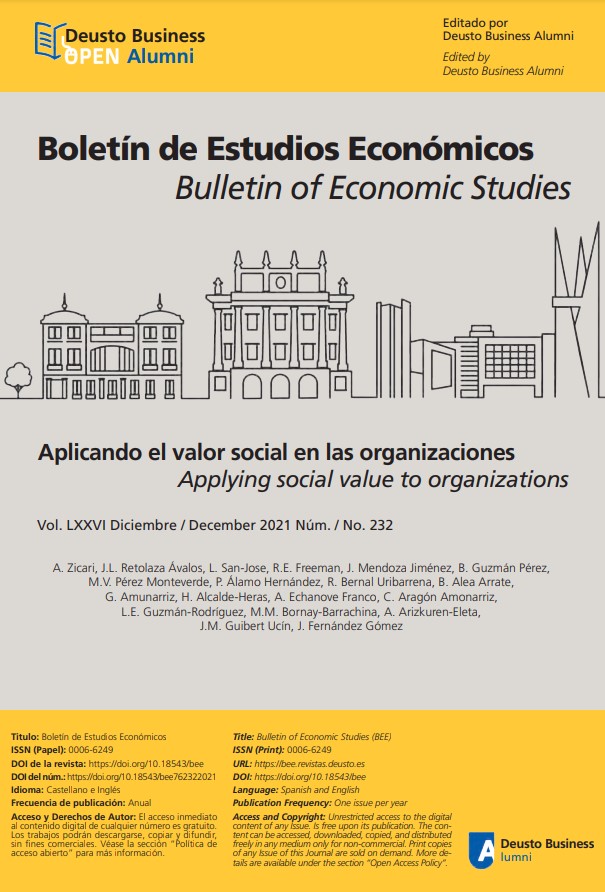Lecciones aprendidas sobre cambio cultural y competencias directivas para la generación de contextos socio-sanitarios favorables a la atención centrada en las personas (ACP)
Resumen
La literatura y la experiencia reflejan la dificultad en la generalización de un cambio cultural en organizaciones socio-sanitarias. La investigación se centra en revelar los intentos directivos para escalar las buenas prácticas generadas en el proyecto piloto “Etxean Ondo” mediante una aproximación cualitativa y constructivista, basada en la teoría fundamentada e investigación acción. El objetivo de este artículo es fundamentar aquellas claves organizativas que han favorecido el cambio cultural y las competencias directivas necesarias para la generación de un contexto organizacional favorable al marco ético de la Atención Centrada en la Personas (ACP). Además de una contribución conceptual, se incluyen una serie de recomendaciones prácticas a modo de “buenas prácticas” que la investigación identifica como claves en la gestión directiva favorable a la ACP: i) acciones relacionadas con la organización informal (dimensión intersubjetiva); ii) acciones relacionadas con los participantes (dimensión subjetiva); iii) acciones relacionadas con la organización formal (dimensión objetiva). El carácter de este estudio es exploratorio, pero se espera que los resultados emergentes, proporcionen elementos de reflexión a otros gestores interesados en emprender una trasformación organizativa
Recibido: 29 octubre 2021
Aceptado: 25 enero 2022
Citas
Abadie, F., Codagnone, C., Lupiáñez-Villanueva, F., & Helter, T. (2014). Strategic intelligence monitor on personal health systems Phase 3 (SIMPHS 3)-Report on the methodological set-up for the SIMPHS3 research. JRC Working Papers, (JRC92703).
Adelman, C. (1993). Kurt Lewin and the origins of action research. Educational Action Research, 1(1), 7-24. DOI: https://doi.org/10.1080/0965079930010102.
Amelung, V., Chase, D., & Reichert, A. (2017). Leadership in integrated care. In Handbook Integrated Care (pp. 221-236). Springer, Cham.
Amunarriz, G. (2020). Fundamentos del liderazgo y gestión estratégica hacia organizaciones sociosanitarias centradas en las personas: una aproximación desde el estudio del caso. Tesis doctoral con mención industrial. Deusto Business School, Universidad de Deusto, Donostia.
Amunarriz, G., & Alcalde-Heras, H. (2020). Towards an integrated care organisation from a CEO perspective. International Journal of Integrated Care, 20(3).
Argandoña, A. (2008). Integrating ethics into action theory and organizational theory. Journal of Business Ethics, 78(3), 435-446. DOI: https://doi.org/10.1007/s10551-006-9340-x.
Bartelings JA, Goedee J, Raab J, Bijl R. (2017). The nature of orchestrational work. Public Management Review, Mar 16; 19(3): 342-60. DOI: https://doi.org/10.1080/14719037.2016.1209233.
Batras, D., Duff, C., & Smith, B. J. (2016). Organizational change theory: implications for health promotion practice. Health Promotion International, 31(1), 231-241. DOI: https://doi.org/10.1093/heapro/dau098.
Bengoa R., .Stout A., Scott B., Mcalinden M., Taylor Ma. (2019). Systems, not structures: changing health & social care. Expert Panel Report for the Ministry of Health of Northern Ireland. Belfast; 2016. Accessed 26 August. https://www.health-ni.gov.uk/publications/systems-not-structures-changinghealth-and-social-care-full-report.
Bernard, P. (1999). Social cohesion: a critique. Canadian Policy Research Networks.
Binns, J. (2008). The ethics of relational leading: gender matters. Gender, Work and Organization, 15(6), 600-620. DOI: https://doi.org/10.1111/j.1468-0432.2008.00418.x.
Birkinshaw, J., Zimmermann, A., & Riasch, S. (2016). How do firms adapt to discontinuous change? California Management Review, 58(4), 36-58. DOI: https://doi.org/10.1525/cmr.2016.58.4.36.
Bishop, C. E. (2014). High-performance workplace practices in nursing homes: an economic perspective. Gerontologist, 54(suPPl 1), 46-52. DOI: https://doi.org/10.1093/geront/gnt163.
Brownie, S., & Nancarrow, S. (2013). Effects of person-centered care on residents and staff in aged-care facilities: a systematic review. Clinical Interventions in Aging, 8, 1-10. DOI: https://doi.org/10.2147/CIA.S38589.
Busetto L, Luijkx K, Calciolari S, Ortiz Lgg, Vrijhoef Hjm. (2018). Barriers and facilitators to workforce changes in integrated care. International Journal of Integrated Care, 18(2): 17. DOI: https://doi.org/10.5334/ijic.3587.
Butterfield, J. (2009). Using grounded theory and action research to raise attainment in, and enjoyment of, reading. Educational Psychology in Practice, 25(4), 315- 326. DOI: https://doi.org/10.1080/02667360903315131.
Chinchilla, N., & Cruz, H. (2011). Diversidad y paradigmas de empresa: un nuevo enfoque. Revista Empresa y Humanismo, 47-79.
Coghlan, D. (2007). Insider action research doctorates: generating actionable knowledge. Higher Education, 54(2), 293-306. DOI: https://doi.org/10.1007/s10734-005-5450-0.
Cooney, A. (2012). «Finding home»: a grounded theory on how older people «find home» in long-term care settings. International Journal of Older People Nursing, 7(3), 188-199. DOI: https://doi.org/10.1111/j.1748-3743.2011.00278.x.
Cristofoli D., Meneguzzo M., Riccucci N. (2016). Collaborative administration: the management of successful networks. Public Management Review, 2017: 275- 283. DOI: https://doi.org/10.1080/14719037.1209236.
Cuñat Giménez, R. J. (2007). Aplicación de la teoría fundamentada. Decisiones Globales, 1-13.
Eisenhardt, K.M., & Martin, J. A. (2000). Dynamic capabilities: what are they? Strategic Management Journal, 21(10-11), 1105-1121.
Fillingham, D, Weir B. (2014). System leadership: lessons and learning from AQuA’s integrated care discovery communities. London: King’s Fund; October. https://www.kingsfund.org.uk/sites/default/files/field/field_publication_file/system-leadership-october-2014.pdf.
Glaser, B G, Strauss, Al. (2017). Discovery of grounded theory: Strategies for qualitative research. Routledge.
González-Ortiz L.G., Calciolari S., Goodwin N., Stein V. (2018). The core dimensions of integrated care: A literature review to support the development of a comprehensive framework for implementing integrated care. Int J Integr Care, Aug 8; 18(3): 10. DOI: https://doi.org/10.5334/ijic.4198.
Goodwin N. (2017). Change management. In Amelung VE, Stein KV, Goodwin N, Balicer R, Nolte E, Suter E (eds.). Handbook Integrated Care. New York: Springer Nature. DOI: https://doi.org/10.1007/978-3-319-56103-5_1.
Gray, C.S., Tang, T., Armas, A., Backo-Shannon, M., Harvey, S., Kuluski, K., & Nelson, M. (2020). Building a digital bridge to support patient-centered care transitions from hospital to home for older adults with complex care needs: protocol for a co-design, implementation, and evaluation study. JMIR Research Protocols, 9(11), e20220.
Gummesson, E. (2000). Qualitative research in management. Qualitative Methods in Management Research, 212. DOI: https://doi.org/10.1016/j.ijproman.2012.11.012.
Hahn, T., Pinkse, J., Preuss, L., & Figge, F. (2015). Tensions in corporate sustainability: towards an integrative framework. Journal of Business Ethics, 127(2), 297-316. DOI: https://doi.org/10.1007/s10551-014-2047-5.
Ham, C., Walsh N. (2013). Making integrated care happen at scale and pace: lessons from experience. London: the King’s Fund. https://www.kingsfund.org.uk/publications/making-integrated-care-happen-scale-and-pace.
Heimans, J., Timms, H. (2014). Understanding “new power”. Harvard Business Review, December. https://hbr.org/2014/12/understanding-new-power.
Joa I, Testad I, Leiknes I, Severinsson E, Rørtveit K, Sætre B (2015). Patients’ experiences of trust in the patient-nurse relationship—A systematic review of qualitative studies. Open Journal of Nursing. 05(03): 195-209. DOI: https://doi.org/10.4236/ojn.2015.53024.
Kadu MK, Stolee P. (2015). Facilitators and barriers of implementing the chronic care model in primary care: a systematic review. BMC Fam Pract, Feb 6; 16(12). DOI: https://doi.org/10.1186/s12875-014-0219.
Kitson, A., Marshall, A., Bassett, K., & Zeitz, K. (2013). What are the core elements of patient-centred care? A narrative review and synthesis of the literature from health policy, medicine and nursing. Journal of Advanced Nursing, 69(1), 4-15.
Koren, M. J. (2010). Person-centered care for nursing home residents: the culturechange movement. Health Affairs, 29(2), 312-317. DOI: https://doi.org/10.1377/hlthaff.2009.0966.
Laurola, H. E. (2018). Integrated care in action: a practical guide for health, social care and housing support: Robin Miller, Hilary Brown and Catherine Mangan, London: Jessica Kingsley Publishers, 2016, pp 232, ISBN: 978-1- 84905-646-5 (paperback). International Journal of Integrated Care, 18(3).
Leutz, W., Bishop, C. E., & Dodson, L. (2010). Role for a labor-management partnership in nursing home person-centered care. The Gerontologist, 50(3), 340-351.
Levinthal, D. A., & March, J. G. (1993). The myopia of learning. Strategic Management Journal, 14(2 s), 95-112. DOI: https://doi.org/10.1002/smj.4250141009.
Lewin, K. (1943). Defining the ‘field at a given time’. Psychological Review, 50(3), 292.
Mccormarck B, Mccance, T (2017). Person-centred in nursing and Health care: theory and practice, 2nd edition. Wiley Blackwell, Oxford.
Mertens, D. M. (2008). Transformative research and evaluation. Guilford Press.
Miller, R. (2018). Transforming integration through general practice: learning from a UK Primary Care Improvement Programme. Int J Integr Care, Apr-Jun; 18(2): 13. DOI: https://doi.org/10.5334/ijic.3044.
Miller, R., & Stein, K. V. (2020). The odyssey of integration: is management its achilles’ heel?. International Journal of Integrated Care, 20(1).
Minkman, M. (2016). The development model for integrated care: a validated tool for evaluation and development. Journal of Integrated Care; 24(1): 38-52. DOI: https://doi.org/10.1108/JICA-01-2016-0005.
Mintzberg, H. (2017). Managing the myths of health care. bridging the separations between care, cure, control, and community. Oakland: Berrett- Koehler Publishers. DOI: https://doi.org/10.1007/978-3-319-53600-2_1.
Mitterlechner, M. (2020). Leadership in integrated care networks: A literature review and opportunities for future research. International Journal of Integrated Care, 20(3).
Nonaka, I. (1994). A Dynamic theory of organizational knowledge creation. Knowledge, Groupware and the Internet, 5(1), 3-42. DOI: https://doi.org/10.1016/b978-0-7506-7111-8.50003-2.
Nooteboom, B. (2000). Learning by interaction: Absorptive capacity, cognitive distance and governance. Journal of Management and Governance, 4(1-2), 69-92. DOI: https://doi.org/10.1023/A:1009941416749.
Pérez- López, J.A. (1993). Fundamentos de la dirección de empresas. Manuales Universitarios. Ediciones Rialp.
Romano, S. A., Klocker, N., Herr, K., & Anderson, G. L. (2005). Slaying my own ghosts: my process into action research. Journal of Geography in Higher Education, 36(1), 149-163. DOI: https://doi.org/10.1080/03098265.2011.589828.
Rosengren, K. (2016). Person-centred care: A qualitative study on first line managers’ experiences on its implementation. Health Services Management Research. 29(3): 42-49. DOI: https://doi.org/10.1177/0951484816637748.
Sancho, M. (2014). Estudio sobre las condiciones de vida de las personas mayores en Euskadi. Gizartea Hobetuz Documentos de Bienestar Social.
Sjögren, K., Lindkvist, M., Sandman, P. O., Zingmark, K., & Edvardsson, D. (2017). Organisational and environmental characteristics of residential aged care units providing highly person-centred care: A cross sectional study. BMC Nursing, 16(1), 1-9. DOI: https://doi.org/10.1186/s12912-017-0240-4.
Solansky, S. T. (2008). Leadership style and team processes in self-managed teams. Journal of Leadership and Organizational Studies, 14(4), 332-341. DOI: https://doi.org/10.1177/1548051808315549.
Stein, K.V. (2016). Developing a competent workforce for integrated health and social care: What does it take? International Journal of Integrated Care; 16(4): 9. DOI: https://doi.org/10.5334/ijic.2533.
Weick, K. E., Sutcliffe, K. M., & Obstfeld, D. (2005). Organizing and the process of sensemaking. Organization Science, 16(4), 409-421.
WHO Europe. (2016). EUR/RC66/15 strengthening people-centred health systems in the WHO European Region: framework for action on integrated health services delivery. copenhagen: WHO Regional Office for Europe. http://www.euro.who.int/en/health-topics/Health-systems/pages/publications/2016/eurrc6615-strengthening-people-centred-health-systems-in-the-who-european-region-frameworkfor-action-on-integrated-health-services-delivery.
Zonneveld N., Driessen N., Stüssgen Ra., Minkman Mm. (2018). Values of integrated care: A systematic review. International Journal of Integrated Care, Oct-Dec; 18(4): 9. DOI: https://doi.org/10.5334/ijic.4172.
Licencia:
Los trabajos publicados en esta revista desde 2021 se encuentran disponibles bajo la licencia Creative Commons Attribution-NonCommercial 4.0 International - CC BY-NC 4.0. La actual política de acceso abierto de la revista no se aplica a los contenidos previos 2021.
Derechos de los autores/as:
Los autores y las autoras conservan los derechos de autor/a sobre sus trabajos publicados en el Boletín de Estudios Económicos y conceden a éste derechos no exclusivos para la explotación de los trabajos con fines de maquetación, publicación y difusión. Esta licencia permite al Boletín de Estudios Económicos distribuir, reproducir y difundir los trabajos en su plataforma y otros medios, siempre bajo las condiciones descritas en este aviso.
Derechos de los lectores/as:
Los lectores y las lectoras pueden leer, descargar, imprimir, buscar, compartir (copiar, redistribuir o enlazar textos completos), o adaptar (remezclar, transformar y construir a partir del material) el contenido, siempre que:
- No se utilicen los materiales con fines comerciales.
- Se cite adecuadamente el trabajo original, incluyendo el nombre de la persona autora y la fuente.
- Se indique claramente cualquier modificación realizada al contenido original.
El uso comercial de los materiales está prohibido sin el permiso expreso de las personas autoras. Para mayor claridad, se considera uso comercial cualquier actividad que tenga como fin la obtención de beneficios económicos o que implique un intercambio comercial directo.
Condiciones de uso:
El uso del contenido no debe infringir los derechos de otras personas, ni debe ser utilizado de manera que pueda dañar la reputación del/la autor/a o del Boletín de Estudios Económicos.
Responsabilidad por el contenido:
Los/las autores/as son responsables del contenido de sus trabajos y el Boletín de Estudios Económicos no se hace responsable de las opiniones expresadas en los mismos.
Más información:
Política de Acceso Abierto, Licencia y Derechos de Autor/a


.jpg)
.jpg)
.jpg)







